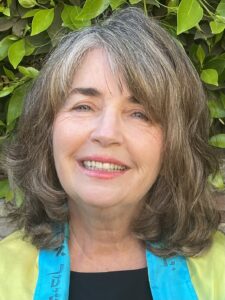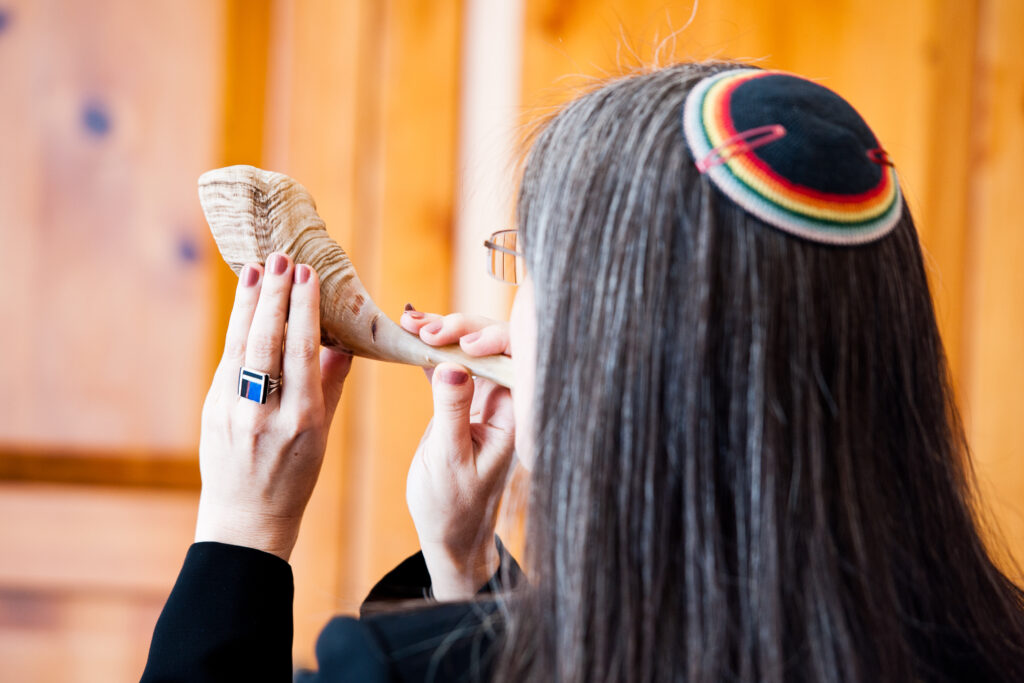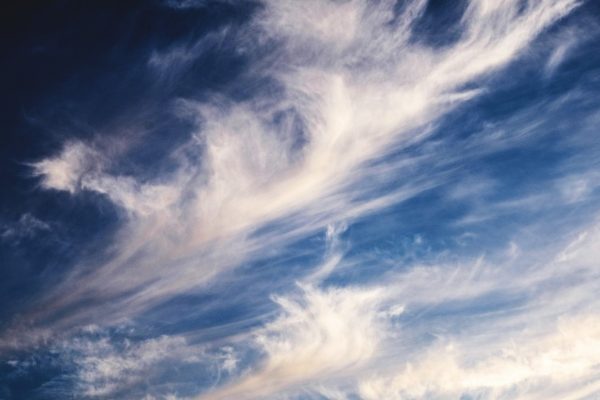![]()
This teaching includes an optional writing prompt.
Breathing is something that often we take for granted. But, as we know, our lives literally depend on our breath. So it’s not surprising that many traditions emphasize conscious breathing as an essential spiritual practice. In Jewish tradition, breath is associated both with human respiration and the Divine presence. Beresheit/Genesis 2:7 tells us than when the breath of life enters the human, it comes to life.
Rabbi Aryeh Kaplan’s book on Jewish meditation contains a practice in which YudHeyVavHey, the Divine Name, is spelled out though a sequence of conscious breathing: Yud is a single point, potential without any expansion – the empty lungs between breaths. Hey is the expansion of the in-breath, bringing potential into actualization. Vav is the distribution of breath within the body and the exchange of gasses in the bloodstream. Heh is the contraction of the outbreath, giving vitality back to the world. This meditation is encapsulated in Psalm 150:6, kol haneshama tehalel ya: “the entire breath praises the Presence, Halleluyah”.
In Hebrew the deep, intimate link between breath and spirituality is expressed in three words for breath and spirit: Neshama comes from breath, and, more specifically, to draw in breath. Nefesh is closely related to the verb that means to exhale. Ruakh can be translated as wind or spirit, and also is used to describe the human experience of being filled with the Spirit of the Divine.
During the month of Elul, the month leading up to the High Holy Days, we use all of these meanings of breath in a very specific way: we blow shofar every day — other than Shabbat —beginning from the first day of Elul and ending on the 28th day.
Elul is our time of spiritual preparation. The Kabbalists interpret the gematria (the numerical value) of Elul — 67 — as equivalent to the gematria of binah — the quality of intuitive understanding. Elul is a time set aside for heshbon hanefesh — making an accounting of our souls, striving to grow in wisdom through self-reflection, through the process of teshuvah — turning and returning to the self that we intuitively understand ourselves to be and to which we want to return.
The word shofar is connected to hollowness. Emptied of its core of bone, reduced to a sheath of keratin and other proteins, the shofar is a ram’s horn, a remnant of a ram’s vitality and virility. In biblical times, the shofar was used to signal danger, to declare war, to accompany the anointment of a king and to celebrate redemption. The shofar is the only ancient biblical instrument to survive as an enduring feature of Jewish spiritual practice.
Rabbi Art Green teaches that the shofar is a wordless sound that evokes a forgotten language.
And Maimonides, the Rambam, characterizes the sound of the shofar during Elul as a “wake up call,” a reminder to those who are “asleep” that it is time to rise up from complacency.
There is nothing like the cry of the shofar. The startling burst of sound that emerges from it calls to something deep within us — Jewish tradition associates the cries of the shofar with the cries of three mothers: Sarah, when she fears that her son is dead; Sisera’s mother, when she realizes that her son IS dead; and the woman in labor, crying out fears and death and, finally, the exaltation of life.
So, the feelings brought forth by the cry of the shofar come perhaps from a hidden place, perhaps from a place that holds truths to which our conscious minds may not have access. The shofar sends cries of pain and joy, sorrow and longing to our deepest selves, to others and to the Divine.
The inertness of the shofar is transformed by our human breath. We put our lips to the mouthpiece and breathe into it—and the cries that the shofar emits reverberate through us, summoning us, calling us to awareness and action. Sending our breath through its tiny aperture is an act of faith: for those of us who are not masters of shofar, the sound that emerges is not always what we expect. We step back from our sense of control — we open our lungs and our hearts and blow, from the smallest place to the widest, most open from self to world to Divine. We consciously blow our breath into the world through shofar, day by day, discovering that we become more confident, more proficient at expressing ourselves. And then, we come to a sacred, mindful pause.
We refrain from blowing shofar on the 29th of Elul, the day before Rosh Hashanah. We step back and take a breath. We store up our breath in preparation for joining our breath with others, with our spiritual community on Rosh Hashanah, the day that is pregnant with eternity, the day on which we move even deeper into our spiritual journey as we transform ourselves into living shofarot, giving voice to our yearning for connection with our own souls, our ancestors, our tradition, our community, the Divine Breath that flows through us and through all that lives.
The 17th century Rabbi Isaiah Horowitz taught that each group of shofar soundings begins with a tekiah — a whole note — and is followed by a shevarim — broken notes, divided into three parts — and then a teru’ah, an entirely fragmented sound. But each broken note is not left in its brokenness. It is followed by another tekiah, a whole sound. The message of the shofar, then, is:
“I started off whole, I became broken, even splintered into fragments, but I shall become whole again! I shall become whole again!”
As a way of embodying this teaching, there’s an activity that will help you to create of yourself a shofar. For this activity, you will need a sheet of paper (five by seven or eight by ten are good sizes), and writing or drawing implements.
Directions:
-
Take a few deep, conscious breaths before you begin. Imagine, with each breath, that you are moving from small to large, from oneness to many to ultimate Oneness.
-
If you wish, draw the outline of a shofar on your paper.
-
Now, write on your paper the words that express any or all of the following:
- your soul’s yearnings
- the teshuvah that you wish for
- your prayer/s for this month of Elul
- the intuitive wisdom for which you are reaching
- the brokenness that you wish to leave behind
- the wholeness that you want to achieve
- If you wish to augment your words with sigils, symbols or embellishments or color, please do so.
-
When you have finished, put down your implements and roll your paper into a tube.
-
Again, take some deep, conscious breaths, considering the power of your breath and your intentions.
-
Now, raise your rolled paper to your lips and blow, with focused kavannah (intentionality) through your paper-tube so that your words are sent, wordlessly, out into the world.
-
Refer to your words throughout Elul, and perhaps beyond the High Holy Days and into the year to come. Whenever the time seems right, again breathe your words and intentions out into the world.
May engaging in mindful Elul shofar practice bring us to wholeness.
Cited resources:
“With trumpets and the sound of the shofar, shout for joy before the Presence, YudHeyVavHey” — Psalms 98.6
“Praise with the blowing of the shofar.” — Psalms 150:3
“Cry aloud, spare not, lift up thy voice like the shofar.” — Isaiah 58:1
“The sound of the shofar during Elul is a ‘wake up call,’ a reminder to those who are ‘asleep’ that it is time to rise up from complacency” — Maimonides, Mishneh Torah, Hilchot Teshuvah 3:4.
“And it came to pass on the third day in the morning, that there were thunders and lightnings, and a thick cloud upon the mountain, and the voice of the shofar very loud; so that all the people in the camp trembled.” — Shemot/Exodus 19:16
“Will a shofar be sounded in the city and the people not tremble?” — Amos 3:6
“If your prayer does not contain your heart’s desire – how can it rise up to God?” – Or Ha-Me’ir 3:16c, as translated in Your Word is Fire, Arthur Green and Barry W. Holtz, editors
“One hundred blasts of the shofar are based on the one hundred cries of the mother of Sisera.” — Talmud Rosh HaShana 33b
“Sarah cries 100 times, believing that her son Isaac has been sacrificed.” — Rav Kasher, Torah Shleima, Chayye Sara
“The woman cried out one hundred times when she is sitting on the birth stool — 99 are tears of pain (death) and one is the cry of life.” — Midrash Tanchuma, Tazria 4:1
 Rabbi Dr. Janet Madden received rabbinic ordination from The Academy for Jewish Religion-California. A widely-published writer and frequent conference presenter, Janet leads Torah Study at Malibu Jewish Center and Synagogue, teaches and leads services for the non-denominational O’ahu Jewish Ohana (Honolulu, HI), serves as Rabbi of Saint John’s Medical Center (Santa Monica, CA), provides Spiritual Direction to rabbinic students at Hebrew Union College’s Los Angeles campus, serves as adjunct faculty of Kavod v’Nichum’s Gamliel Institute and for Open Temple’s Soul Journey program and is a member of the Board of Governors of Reconstructing Judaism.A dedicated hand quilter and gardener, Janet lives in Santa Monica CA with her husband, dog, cat and flock of backyard chickens.
Rabbi Dr. Janet Madden received rabbinic ordination from The Academy for Jewish Religion-California. A widely-published writer and frequent conference presenter, Janet leads Torah Study at Malibu Jewish Center and Synagogue, teaches and leads services for the non-denominational O’ahu Jewish Ohana (Honolulu, HI), serves as Rabbi of Saint John’s Medical Center (Santa Monica, CA), provides Spiritual Direction to rabbinic students at Hebrew Union College’s Los Angeles campus, serves as adjunct faculty of Kavod v’Nichum’s Gamliel Institute and for Open Temple’s Soul Journey program and is a member of the Board of Governors of Reconstructing Judaism.A dedicated hand quilter and gardener, Janet lives in Santa Monica CA with her husband, dog, cat and flock of backyard chickens.











One Response
Yasher Koach, Rabbi!
Your inspired teaching is, you’ll excuse the irony, Breath-Taking.
With your permission , I will read large excerpts of it to my congregation in the next few weeks, before blowing Shofar with them.
With Deepest Gratitude,
Cantor Marc